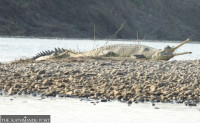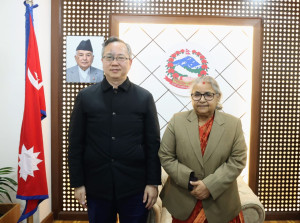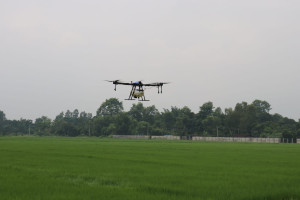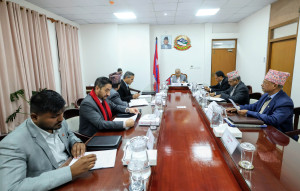National
Climate crisis is uprooting villages in Mustang
As water sources dry up due to erratic snowfall and rising temperatures, villagers in the high-altitude Himalayan region abandon ancestral homes, becoming ‘climate refugees’, as they call themselves.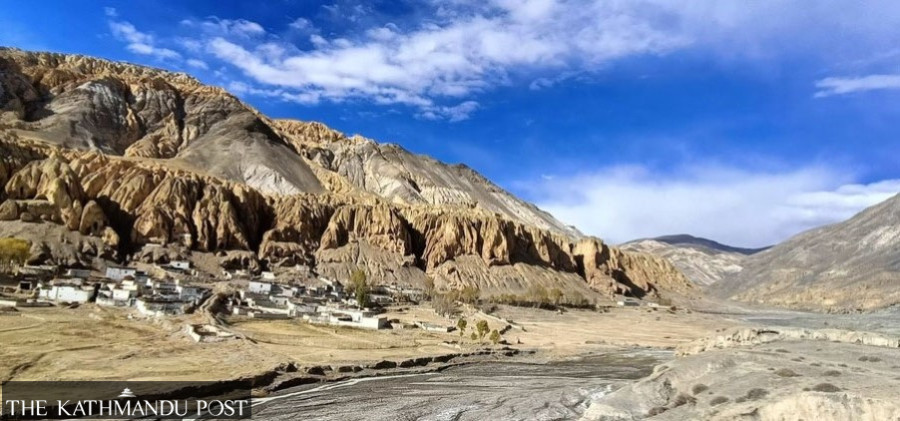
Ghanashyam Khadka
In the stark and arid landscapes of Upper Mustang, climate change has begun to redraw the map of human habitation. Entire villages—some centuries old—are now being emptied as springs dry up and water for drinking, irrigation, and livestock becomes scarce. In an unfolding humanitarian and ecological crisis, Samjong and Dhe, two ancient settlements, have been largely abandoned, their residents forced to relocate in search of water and survival.
Eighteen families from Samjong in Lomanthang Rural Municipality–2, totalling 85 individuals, began their exodus in 2014–15, resettling on the banks of the Namsung river within the same ward. The new site, dubbed ‘New Samjong’, lies on a riverbed once belonging to the former king of Mustang, interspersed with some public land.
“Life in New Samjong is relatively easier because water for drinking and irrigation is readily available,” said Karma Namgyal Gurung, ward chair of Chhoser, Lomanthang–2. “The inter-country road that now connects Namsung has also brought other facilities. But the shift was born out of desperation. After the springs dried up in Samjong, the entire community was thrown into crisis.”
The changing climate has disrupted traditional snowfall and rainfall patterns in Mustang for over two decades. Winters that once brought ample snow, essential for replenishing groundwater, are now drier. Monsoons, once rare in this rain-shadow region, are growing in intensity and irregularity. This dual disruption has damaged not just water sources but also farming cycles and livestock-rearing practices—lifelines for the local population.
The old Samjong village lies ghostly and barren. Abandoned houses, empty fields, and wild horses grazing through the desolate landscape mark the remnants of a community forced into retreat.
Dhe village in the neighbouring Lo-Ghekar Damodarkunda Rural Municipality–5 shares a similar fate. Once home to over 20 families, Dhe was vacated in 2007 after its water sources dried up. The displaced residents now live two hours downhill, at 3,700 metres, along the banks of the Kali Gandaki river in a settlement known as Thamsung.
“This is not just an immediate challenge for our generation—it is a serious threat to the future,” warned Lopsang Chhopel Bista, chair of Lo-Ghekar Damodarkunda. “We are preparing a climate adaptation plan at the local level to mitigate the worsening effects of climate change.”
Evidence from local meteorological stations supports these ground-level observations. Statistics of the Department of Hydrology and Meteorology show the highest recorded annual rainfall in Upper Mustang was below 200mm before 2009. That figure jumped to 331mm by 2023. In Jomsom, the district headquarters, rainfall has more than doubled—from under 300mm in 2010 to 665mm by 2023.
Temperature data is even more telling. Nepal’s average annual maximum temperature is increasing by 0.056°C per year—an increment that may seem negligible, but in fragile mountain ecosystems, even small shifts have outsized impacts.
The International Centre for Integrated Mountain Development (ICIMOD) warns that even if global temperature rise is limited to 1.5°C, up to one-third of Himalayan ice could vanish. “The geography of Mustang naturally lacks the capacity to store water. Its entire ecosystem depends on regular snowfall,” explained Dr Arun Bhakta Shrestha, a senior climate change expert at ICIMOD. “With warmer winters, snow falls less frequently and melts more quickly, which prevents groundwater recharge and causes springs to dry out.”
These changes are already affecting agriculture. Traditionally, Mustang's farmers would plant barley, buckwheat, mustard, and potatoes from March to mid-April, harvesting by October. This delicate rhythm relied on late winter snowmelt. But the vanishing snow means dry soil and water shortages during crucial planting periods.
“In the past, our soil absorbed moisture from winter snow. Now, with no snowfall, it dries out. The streams near our village no longer flow, making irrigation nearly impossible,” said 60-year-old Chhingju Gurung, a displaced resident of Samjong. “That’s why we carried our children and whatever we could and moved to Namsung. Life is easier there, but we still long for our homeland.”
The neighbouring village of Tetang in Varagung Muktichhetra Rural Municipality–3 is facing a similar crisis. Irrigation water is sourced from springs across the border in Manang, four hours uphill. “Those springs are drying too, because of reduced snowfall,” said Dhurpo Gurung, a local ward member. “We used to have enough for our canals. Now the flow is weak, and even reaching the fields is a challenge. Laying pipes would be expensive and difficult.”
Ecological consequences are also mounting. As snow lines recede and snowfall zones shift higher, so too do alpine meadows—the grazing grounds for yaks and mountain goats.
“Now we must climb higher to find pasture,” said Umesh Paudel, head of the Annapurna Conservation Area Project (ACAP) office in Lomanthang. “This increases the risk of snow leopard attacks on livestock. We’ve also seen a decline in traditional animal husbandry because of reduced grazing lands.”
Climate-induced migration is already reshaping Mustang’s landscape. Once-thriving villages are crumbling into ruins. Fertile fields have turned into grazing lands for stray horses. Locals now refer to themselves as “climate refugees”—an identity not chosen, but forced upon them.
Adding to the pressure is the rising frequency of crop diseases and pests, rarely seen at these altitudes before. “We are initiating adaptation programmes—preserving indigenous crops, afforestation, and improving animal shelters to protect against predators,” said Paudel.
ICIMOD’s 22-year Snow Update Report confirms that 2024 marked the second-lowest snow cover on record across the Himalayan region. Over the past 13 years, snow coverage has been consistently declining, reinforcing the urgency for both local action and international support.
“The Himalayas are facing three intertwined crises: climate change, biodiversity loss, and pollution,” said Dr Shrestha. “Snow is now falling at higher elevations, shrinking the area traditionally covered during winter. This not only changes water availability but also accelerates the rate at which glaciers melt.”
For Samjong and Dhe, the battle against climate change is already lost. Their stories, however, serve as a chilling warning for other settlements in Mustang and the wider Himalayan belt.
With the Himalayan cryosphere melting faster than ever and local ecosystems buckling under stress, the people of Mustang find themselves on the frontlines of a crisis they did little to create. Their resilience is remarkable—but it may not be enough without swift global action.




 7.12°C Kathmandu
7.12°C Kathmandu




